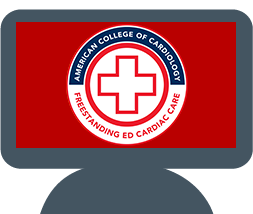FreeStanding ED Cardiac Care Certification
Our mission to transform cardiovascular care and improve heart health knows no geographic boundaries; neither should the use of appropriate and guideline-driven practices to ensure best outcomes. We work with FreeStanding EDs so that patients experiencing acute signs and symptoms of heart attack, atrial fibrillation or heart disease receive the same expert diagnosis, treatment and care as those who enter the emergency department of an established hospital.
Typically located in rural, suburban, and inner-city areas, FreeStanding EDs are more convenient for patients who need access to emergency care closer to home. They are also commonly identified as facilities that are structurally separate from a hospital, but are feeders to larger urban medical centers or regional medical centers.
In the fight to prevent adverse cardiac outcomes, emergency responders, nurses and physicians know that time is critical to diagnosis. This reality, coupled with the knowledge that distance to emergency treatment also influences outcomes, corresponds with the increase of visits to FreeStanding Emergency Departments (EDs).
Because they are at the front line of emergency care for a large percentage of the population, the early stabilization efforts and processes used by FreeStanding EDs are critical. As a resource to those at the front line, we offer certification for the cardiac care delivered by FreeStanding EDs.
Learn more about the benefits of this certification.







